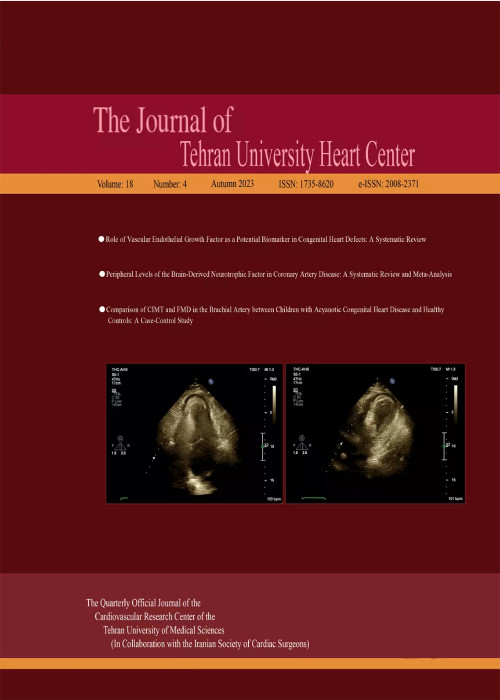Evaluation of the Effect of Elective Percutaneous Coronary Intervention as a Treatment Method on the Left Ventricular Diastolic Dysfunction in Patients with Coronary Artery Disease
Author(s):
Abstract:
Background
Although percutaneous coronary intervention (PCI) is an excellent therapy for coronary artery disease, there is a paucity of information on the efficacy of PCI in improving diastolic function, especially in Iran. Because of the high prevalence of left diastolic dysfunction in coronary artery disease patients and its probable progression to heart failure, an evaluation of the role of PCI in improving diastolic function is required.Methods
Thirty patients scheduled for elective PCI were enrolled in this study providing that their systolic ejection fraction was > 40%. Before PCI and 48 hours and 3 months after PCI, echocardiography was done to evaluate some diastolic values in these patients.Results
The mean age of all the patients was 54 ± 10 year, and 20 patients were male. All the patients had a low degree of left ventricular diastolic dysfunction. Isovolumic relaxation time (115 ± 10 before treatment versus 120 ± 1 and 119 ± 3 respectively 48 hours and 3 months after treatment), mitral E wave velocity in septal (0.70 ± 0.05 before treatment vs. 0.71 ± 0.15 and 0.72 ± 0.12 respectively 48 hours and 3 months after treatment), and the peak velocity of late filling due to atrial contraction (mitral A wave velocity) in septal (0.74 ± 0.02 before treatment vs. 0.73 ± 0.01 and 0.68 ± 0.16 respectively 48 hours and 3 months after treatment) showed improvement after PCI. It is notable that early diastolic mitral annulus velocity (E¢) wave velocity in the septal part of the mitral annulus improved significantly 48 hours and 3 months after PCI (p value < 0.05). The early-to-late diastolic tissue velocity ratio of the mitral annulus (E/A) ratio of the mitral inflow improved 48 hours after PCI; it was statistically significant (p value = 0.05). Also, mitral A wave velocity in septal and the E/A ratio of the mitral inflow improved significantly 3 months after PCI (p value < 0.05). Conclusion
Improvement in some of values related to left ventricular diastolic function followed by PCI shows that this method can be used to improve cardiac diastolic function in patients with symptomatic coronary artery disease.Language:
English
Published:
The Journal of Tehran University Heart Center, Volume:5 Issue: 4, Oct 2010
Page:
194
magiran.com/p799439
دانلود و مطالعه متن این مقاله با یکی از روشهای زیر امکان پذیر است:
اشتراک شخصی
با عضویت و پرداخت آنلاین حق اشتراک یکساله به مبلغ 1,390,000ريال میتوانید 70 عنوان مطلب دانلود کنید!
اشتراک سازمانی
به کتابخانه دانشگاه یا محل کار خود پیشنهاد کنید تا اشتراک سازمانی این پایگاه را برای دسترسی نامحدود همه کاربران به متن مطالب تهیه نمایند!
توجه!
- حق عضویت دریافتی صرف حمایت از نشریات عضو و نگهداری، تکمیل و توسعه مگیران میشود.
- پرداخت حق اشتراک و دانلود مقالات اجازه بازنشر آن در سایر رسانههای چاپی و دیجیتال را به کاربر نمیدهد.
In order to view content subscription is required
Personal subscription
Subscribe magiran.com for 70 € euros via PayPal and download 70 articles during a year.
Organization subscription
Please contact us to subscribe your university or library for unlimited access!


